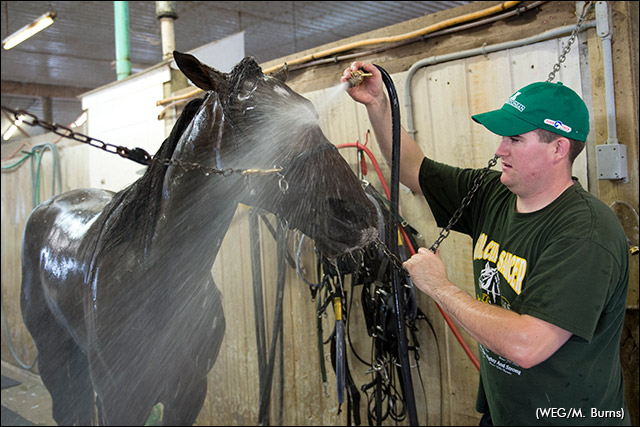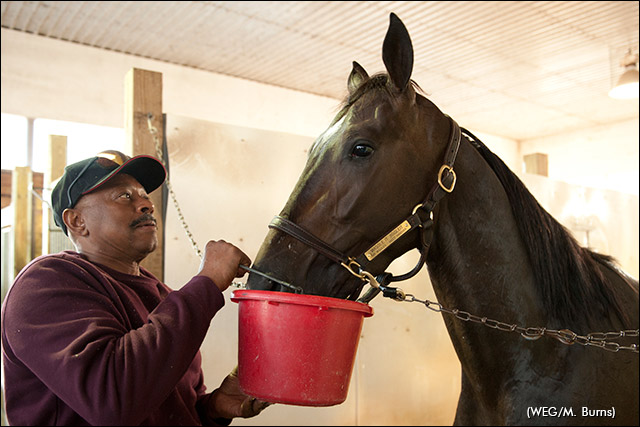The latest research indicates that continuous bathing with cool water, without scraping, is the best way to cool a horse down. (updated July 2021)
Bathing horses is second nature to most in the harness racing business, but there are a few things to keep in mind during times of hot and humid weather conditions.
• When the temperature of the skin and the environmental temperature are equal, horses lose heat by evaporation of sweat, BUT when the temperature and humidity are both high, evaporation is inefficient to cool the horse and core body temperatures may become dangerously high. Water applied to the horse will cool it by conduction which is much faster than evaporation. As the horse cools down, water left on the horse will keep it cool by evaporation. “A wet horse will cool faster than a dry horse even at 100% humidity” - Dr. David Marlin, 2018.
• The large muscles required to exercise/race generate a lot of heat also contributing to a rise in core body temperature.
• Hyperthermia (increased body temperature), if severe, will affect blood flow to the brain and to the intestines leading to behavioural changes (depression, unpredictable behaviour), gait abnormalities and possibly signs of colic and/or diarrhea.
• Bathing horses with cold water in hot weather will not cause them to tie-up. Horses may tie-up due to losses of fluid and electrolytes in sweat (Standardbreds can lose up to 30L of fluid as sweat associated with exercise), reduced muscle energy stores and muscle damage due to high intramuscular temperatures.
• Bathing horses repeatedly in cold water and not scraping them will lower their body temperature more quickly than bathing and then stopping to scrape the water off. Recent research conducted in Australia (Kang, et al, 2019) demonstrated that repeatedly bathing a hot horse lowered the internal body temperature of the horse. When the water was scraped off the horse, the internal temperature actually started to increase again.
Signs of exertional heat illness (Heat Stress) – a horse may have a few or many of these signs depending on the severity of the condition
• Hot skin to the touch
• Rapid breathing with flared nostrils
• Irritable or agitated behaviour such as kicking out behind
• “Glassy” eyes
• Staggering or weak gait
• High core body temperature (greater than 105.8⁰F/41⁰C approximately). The rectal temperature is the last to increase so internal temperatures of the muscles will be even higher.

Treatment
For more mild cases:
• Bathe the horse in cool water and repeat as necessary. Allow to air dry.
• Many horse people follow the tradition of putting a towel over the lower back of the horse to cover the “kidneys” when cooling the horse out. The kidneys are located around 20cm (8 in) below the surface of the back and are covered by 1-2cm of fat in the average racehorse. Putting a towel over this area will not make any difference to kidney temperature and may impede cooling.
For more severe cases:
• Repeatedly bathe or continuously hose the horse using cold water for at least 5 minutes. If using a bucket, apply cold water every minute (a person on each side) for at least 5 minutes. After this time the rectal temperature should be near normal but check to make sure. Allow to air dry.
• Call your veterinarian as sedation or intravenous fluids may be needed.
For both situations:
• After the horse is more comfortable (and able to walk), move the horse from a hot and humid paddock to a shaded area outside.
• Allow the horse to drink clean and cool water when willing. Horses that refuse to drink may require intravenous fluid therapy. Discuss with your veterinarian.
• Bathing may need to be repeated as core temperatures can sometimes increase again as heat stored in muscle is released.
• Monitor the horse to make sure it is eating and drinking normally and produces normal urine and manure in both appearance and amount during the next 24 hours. Call your veterinarian if there is anything abnormal or if you have concerns.

Prevention
• Jog/train during cooler parts of the day when possible (e.g. before 10 a.m.).
• Provide fresh, clean water along with daily electrolytes provided in the feed, separately in a tub, with a salt block or in the water. If providing in the water, make sure there is also a bucket of fresh water available without electrolytes.
• Observe whether your horse is sweating a normal amount for the level of exercise. Discuss with your veterinarian if you have concerns.
• Ensure the horse is adequately hydrated. If you are not sure how to assess hydration or have concerns, please ask your veterinarian for help as your horse may have an underlying medical condition that needs to be addressed.
The views presented in Trot Blogs are those of the author and do not necessarily represent those of Standardbred Canada.

